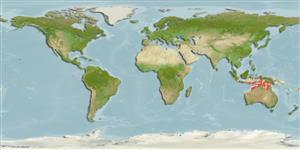Classification / Names
Common names | Synonyms | Catalog of Fishes (gen., sp.) | ITIS | CoL | WoRMS | Cloffa
Actinopterygii (ray-finned fishes) >
Siluriformes (Catfish) >
Ariidae (Sea catfishes) > Ariinae
Environment / Climate / Range
Ecology
Marine; freshwater; brackish; demersal; pH range: 7.5 - 8.2; dH range: 18 - 30; anadromous. Tropical; 24°C - 32°C (Ref. 2059), preferred ?; 3°S - 19°S
Western Pacific: northern Australia and southern New Guinea.
Size / Weight / Age
Maturity: Lm ? range ? - ? cm
Max length : 60.0 cm SL male/unsexed; (Ref. 44894)
Adults inhabit freshwater rivers and lagoons, as well as brackish estuaries and coastal marine waters. Can tolerate temperatures from 11°C to 38°C. Large groups of juveniles are often encountered (Ref. 44894). Feed on arthropods, insects, aquatic plants, mollusks, prawns, crayfish, fishes and bottom detritus. Nest is constructed among gravel where eggs are deposited forming a mound (Ref. 205). The only species among oral incubating ariids exhibiting no parental care (Ref. 205). Breeding takes place from September to February (Ref. 44894). Marine populations of A. graeffei appear to undertake extensive anadromous migrations associated with breeding, but no such movements were observed in the fluviatile population studied (Ref. 38559).
Life cycle and mating behavior
Maturity | Reproduction | Spawning | Eggs | Fecundity | Larvae
Nest is constructed among gravel where eggs are deposited forming a mound (Ref. 205). The only species among oral incubating Ariidae exhibiting no parental care (Ref. 205).
Allen, G.R., 1989. Freshwater fishes of Australia. T.F.H. Publications, Inc., Neptune City, New Jersey. (Ref. 5259)
IUCN Red List Status (Ref. 115185)
CITES (Ref. 94142)
Not Evaluated
Threat to humans
Traumatogenic (Ref. 58010)
Human uses
More information
ReferencesAquacultureAquaculture profileStrainsGeneticsAllele frequenciesHeritabilityDiseasesProcessingMass conversion
Tools
Special reports
Download XML
Internet sources
